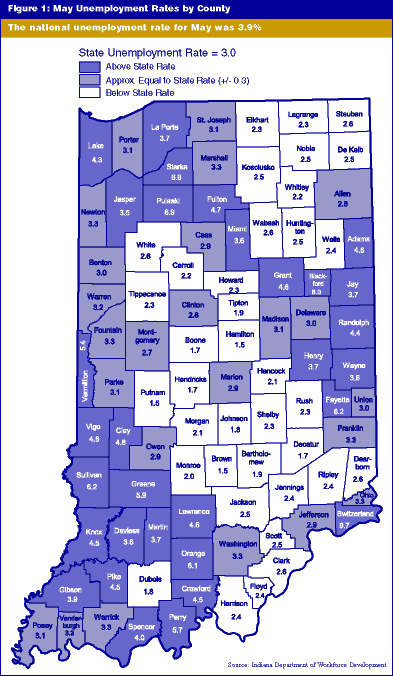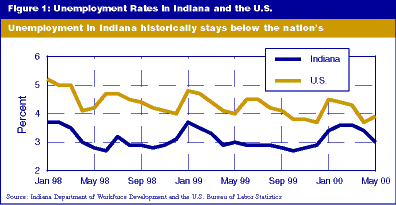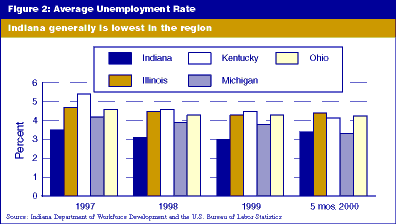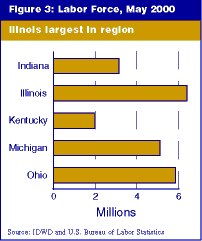May Unemployment Rate Falls Even as Labor Force Grows
Indiana's unemployment rate dropped to 3% in May, bringing it down to a level consistent with the same month in 1998 and 1999.
Click on map to see larger version.

The rate typically falls in the spring, but April's rate did not come down as much this year as it did in 1998 or 1999. Some analysts speculated that April's higher rate signaled a slowdown in Indiana's economy. Then came a healthy drop in May. Taken together, the first five months did not show any significant increase in the unemployment rate.
Indiana's rate decline came despite growth in the state's labor force. A steady expansion of the labor force this year reversed the shrinkage that occurred in 1999. Last year, in most months, the labor force was down compared to the same month in 1998. In the first five months of 2000, the labor force grew at least 1.3% every month, compared to the same month in 1999.
The total labor force in Indiana stood at 3.13 million in May, according to estimates from the Indiana Department of Workforce Development and the U.S. Bureau of Labor Statistics. That's close to the record labor force estimate of 3.18 million set in June 1995.
Coupled with the declining unemployment rate, this larger labor force resulted in a near-record number of Hoosiers at work in May. The total number of employed people surpassed 3.03 million, and was, in fact, just 5,000 people shy of the record 3.04 million in June 1998.
Indiana Unemployment Rate Lower than in Neighboring States
In May, Indiana continued to post a lower unemployment rate than the nation as a whole. Indiana's rate fell four-tenths of a point to 3%, while U.S. unemployment edged up from 3.7% to 3.9% (see Figure 1).

For more than 10 years, Indiana's unemployment rate has almost always been lower than the national rate. Sometimes a persistent rate difference is due to regional factors. If so, several neighboring states might exhibit the same kind of differential from the U.S. numbers. Indiana's low unemployment rate, however, is not a regional phenomenon. In fact, since 1990, Indiana's unemployment rate has been consistently lower than the rates in neighboring states. The unemployment rates for Indiana and its four neighbors—Illinois, Kentucky, Michigan and Ohio—for the most recent four years are shown in Figure 2.

Neighboring states generally had unemployment rates ranging from half a percentage point to two full points higher than Indiana's. Illinois and Kentucky were both at about 4% in May 2000, compared to Indiana's 3%. Ohio came down from 4.9% in February to 3.6% in May.
"There does not appear to be a problem with the data that would explain this pattern," said Charles Mazza, director of Labor Market Information at the Indiana Department of Workforce Development. "The U.S. Bureau of Labor Statistics uses the same formula to estimate the unemployment rate for all states."
Part
of the explanation could be mix. "Indiana's economy," said Mazza,
"has a higher proportion of its jobs in manufacturing. And that sector
has grown very well in recent years."
Indiana's low unemployment rate is one likely factor in the growth of its
total labor force—that is, the number of people in the state who are
working or looking for work. With a labor force of 3.1 million people, Indiana
ranks fourth in the five-state region (see Figure 3). Illinois and Ohio each
have a labor force that is about twice the size of Indiana's. Michigan's is
about 65% larger, and Kentucky's, the smallest of this group, is about two-thirds
the size of Indiana's. Indiana's share of the five-state total has remained
constant for several years.

